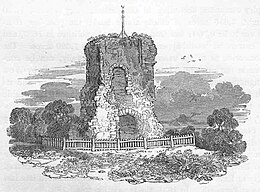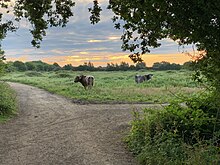Knepp Castle

The medieval Knepp Castle (sometimes referred to as 'Old Knepp Castle', to distinguish it from the nearby 19th-century mansion) is to the west of the village of West Grinstead, West Sussex, England near the River Adur and the A24 (grid reference TQ163209). The castle was probably founded by the Braose family in the 12th century. King John confiscated the castle along with the Braose lands in 1208. Knepp was used as a hunting lodge, and John visited the castle several times. He ordered its destruction in both 1215 and 1216 during the First Barons' War.

Knepp Castle continued to be used into the 14th century and hosted reigning monarchs on several occasions. The castle eventually fell out of use, and by the early 18th century was mostly destroyed. Later that century, stone from the castle was used to build a nearby road. The land around the castle is now the site of Knepp Wildland.
History
[edit]The name is thought to come from the Old English word cnæp, referring to the mound on which the castle stands.[1]
Knepp was a motte castle, probably founded in the 12th century by William de Braose,[2] in the Rape of Bramber. In 1208 King John confiscated a later William de Braose's land, including Knepp.[3][1] While John's motivation is uncertain, he came to view William de Braose as a threat;[4] in historian Sidney Painter's view the treatment of the Braose family was "the greatest mistake John made during his reign ... it made his cruelty known to all his barons", and contributed to the discontent of the barons who later revolted against John's rule.[5]

The first surviving record of the castle is dated to 1210. Royal records document spending at the castle in the 1210s on general repairs, building a chimney, and repairing a pond or moat.[1] John was present at Knepp Castle on 6 April 1211, as evidenced by a charter confirmed on that date.[6] Queen Isabella also stayed at the castle for eleven days in either 1214 or 1215.[7]
In 1215, John was at war with the barons of England. Shortly after losing control of London, John wrote to Roland Bloett on 18 May instructing him to remove whatever he could carry from Knepp and send it to Bramber Castle, and then "totally destroy" Knepp Castle.[8][1] This was followed by a second order to destroy (slight) the castle, given by John on 13 June 1216; on this occasion he ordered Roland Bloett to "cause the castle of Cnappe [Knepp], without delay, to be burnt and destroyed".[9]

In addition to John the castle had a succession of royal visitors, including Henry III in 1218, Edward II in 1324 and Richard II in 1384.[2] Simon de Montfort seized Knepp Castle from William de Braose, and later returned it.[10] Subsequently, it fell into decline and deteriorated.
Later history
[edit]
A skirmish may have taken place near Knepp Castle during the English Civil War, referred to as the 'Battle of Knepp' by Sir Charles Burrell. The event was related by James Charles Michell, a member of the Sussex gentry, in the early 19th century as a piece of oral history handed down from his father. According to Michell a parliamentarian force defeated a royalist force on 19 July 1648. Michell also reported that a cannonball had been found near the castle, but did not state when or give a precise location.[11] Historian Richard Symonds suggests that the event caused considerable damage to the castle and contributed to its abandonment,[12] though the Victoria County History of Sussex notes that it is unclear when the castle was destroyed. The bulk of the castle had been pulled down by the 1720s.[1][2]
Ownership of the castle was linked to the manor of Knepp. In 1788 the manor was purchased by Sir Charles Raymond, and descended through the Burrell family.[13] Antiquarian Francis Grose visited the ruins in 1775, and wrote "so completely has been the work of demolition in the instance of this castle, that a reasonable conjecture cannot be hazarded from a view of the ruins themselves, as they then appeared, of its original form and extent".[14] About 55 years later the Rev. Edmund Cartwright observed that the ruins had further deteriorated, with stone from the castle taken to be used in roadmaking.[15][16] In the early 19th century the remnants were reinforced and fenced in by Sir Charles Burrell to protect them from further deterioration.
The name 'Knepp Castle' is also applied to the castellated Gothic Revival mansion built nearby in the early 19th century by Sir Charles Merrik Burrell, to the designs of John Nash,[17] and currently[when?] the home of Sir Charles Burrell, 10th Baronet.
In 1951, the castle was designated a scheduled monument, a scheme intended to protect nationally important archaeological sites. The protected area covers the whole of the mound and a section of path leading west from the castle.[18][2] The wall on top of the motte was given additional protection in 1959 when it was designated a Grade II listed building.[19]
The Society for Medieval Archaeology funded geophysical surveys at the castle in 2021 and 2022, with the aim of finding out more about the layout of the castle and searching for evidence of burning which could relate to King John's orders to burn Knepp. While there was no evidence of burning was found, the surveys did find possible buried archaeology.[20]
Layout
[edit]
The castle stands on an oval mound, modelled from a natural feature, surrounded by a ditch and ramparts. The ditch, fed from a nearby pond, formed a moat which still contained water at the beginning of the 18th century.[1]
The above-ground remains of the castle consist of a single wall 11 metres high, 9.5 metres long, and 2.5 metres thick, with a doorway and another opening above it. This wall apparently formed the north end of the west wall of a tower or keep.[1] The wall is faced with Horsham Stone,[1] a type of sandstone found in the region.
Thirteenth and fourteenth century documents record a chapel, and domestic structures including a hall and stables at the castle.[22] The arrangement of the buildings and whether they were standalone structures is not recorded in the contemporary documents.[1]
Knepp Wildland
[edit]
The land around the castle is now the site of Knepp Wildland, the first large-scale rewilding project in England, created from 1,400 hectares or 3,500 acres of former arable and dairy farmland owned by Sir Charles Burrell, 10th Baronet.[23]
References
[edit]- ^ a b c d e f g h i Hudson 1986a, pp. 111–112.
- ^ a b c d Historic England. "Knepp Castle (1010765)". National Heritage List for England. Retrieved 25 July 2021.
- ^ Hudson 1980, pp. 1–7.
- ^ Turner 2004.
- ^ Painter 2019, pp. 249–250.
- ^ Sharpe 1852, p. 144.
- ^ Burrell 1850, p. 6.
- ^ Turner 1870, pp. 18–19.
- ^ Burrell 1850, p. 11.
- ^ Rigollet 2021, p. 345.
- ^ Gilbert 1964, pp. 112–113.
- ^ Symonds 2012, p. 17.
- ^ Hudson 1986b, pp. 112–117.
- ^ Quoted in Turner 1870, p. 14
- ^ Cartwright 1830, p. 294, "A considerable portion of the outworks remained till within the last fifty years, but which affording greater temptation to the road-maker than the stone quarry, have been carried away.".
- ^ This was also noted in Horsfield 1835, p. 247, note 1: "[the castle's] scite and extent were clearly defined ... by a stone wall ... which was pulled down, and the materials converted chiefly to the purposes of Horsham and Steyning turnpike road, when first made"
- ^ Historic England. "Knepp Castle and stables adjoining to north west (1354214)". National Heritage List for England. Retrieved 28 July 2011.
- ^ "Scheduled Monuments". HistoricEngland.org.uk. Retrieved 30 September 2022.
- ^ Historic England. "The ruins of the medieval Knepp Castle, Shipley (1180576)". National Heritage List for England. Retrieved 30 September 2022.
- ^ Nevell & Chaussée 2023.
- ^ Clinch 1905, p. 472.
- ^ Williamson et al. 2019, p. 700.
- ^ Battle 2018.
Bibliography
[edit]- Battle, Laura (28 September 2018). "Rewilding revives a country estate". Financial Times.
- Burrell, Charles (1850). "Documents Relating to Knepp Castle. Collected by the Rev. John Sharpe, late curate of Shipley". Sussex Archaeological Collections. 3: 1–12. doi:10.5284/1085090.
- Cartwright, Edmund (1830). The Parochial Topography of the Rape of Bramber, in the Western Division of the County of Sussex. vol ii part the second. London: J. B. Nichols and Son.
- Clinch, George (1905). "Ancient earthworks". The Victoria history of the county of Sussex, Volume One. London.
{{cite book}}: CS1 maint: location missing publisher (link) - Gilbert, Richard (1964). "The Battle of Knepp". Sussex Notes and Queries. 16 (4): 112–114.
- Horsfield, Thomas Walker (1835). The History, Antiquities, and Topography of the County of Sussex. Volume the Second. Lewes: Sussex Press.
- Hudson, T P (1980). "Bramber Rape". In T P Hudson (ed.). A History of the County of Sussex: Volume 6 Part 1, Bramber Rape (Southern Part). Institute of Historical Research. pp. 1–7.
- Hudson, T P (1986a). "Shipley: Knepp Castle". In T P Hudson (ed.). A History of the County of Sussex: Volume 6 Part 2: Bramber Rape (North-Western Part) including Horsham. Institute of Historical Research. pp. 111–112.
- Hudson, T P (1986b). "Shipley: Manors and other estates". In T P Hudson (ed.). A History of the County of Sussex: Volume 6 Part 2: Bramber Rape (North-Western Part) including Horsham. Institute of Historical Research. pp. 112–117.
- Nevell, Richard; Chaussée, Scott (2023), "Geophysical surveys at Knepp Castle, Sussex: a 'slighted' site?", Medieval Archaeology, 67 (2): 490–496
- Painter, Sidney (2019) [1949]. The Reign of King John (reprint ed.). Baltimore: Johns Hopkins University Press. ISBN 978-1-4214-3516-9.

- Rigollet, Amelie (2021). Mobilites Du Lignage Anglo-Normand De Briouze MI -XIE Siecle-1326. Histoires de famille. La parenté au Moyen Age (in French). Vol. 22. [S.l.]: Brepols Publishers. doi:10.1484/M.HIFA-EB.5.121749. ISBN 978-2-503-59248-0. OCLC 1246142530. S2CID 246160737.
- Sharpe, John (1852). "Documents relating to Knepp Castle, additional to those in Vol III". Sussex Archaeological Collections. 5: 143–146. doi:10.5284/1085123.
- Symonds, Richard (2012), Knepp Castle Timeline (PDF), Horsham District Archaeology Group, archived from the original (PDF) on 8 December 2022
- Turner, Edward (1870). "Steyning and West Grinstead Churches, and the Ancient Castle of Knepp". Sussex Archaeological Collections. 22: 1–21. doi:10.5284/1085409.
- Turner, Ralph V. (2004). "Briouze [Braose], William de". In Matthew, H. C. G.; Harrison, B. (eds.). Oxford Dictionary of National Biography (online ed.). Oxford: Oxford University Press. doi:10.1093/ref:odnb/3283. Retrieved 1 October 2022. (Subscription or UK public library membership required.)
- Williamson, Elizabeth; Hudson, Tim; Musson, Jeremy; Nairn, Ian (2019), Sussex: West, Buildings of England, New Haven and London: Yale University Press, ISBN 978-0-300-22521-1


 French
French Deutsch
Deutsch